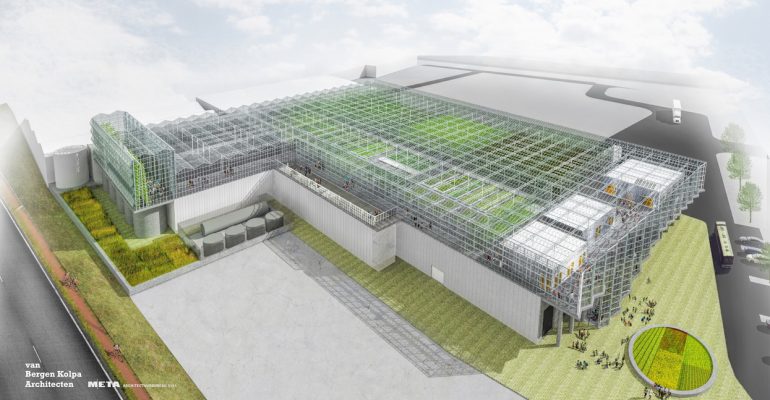The AVF announces Inagro as one of our newest members.
Based in Roeselare (West Flanders, Belgium), Inagro is an applied-research facility in the heart of one of Europe’s most innovative horticultural regions. Its mission is to be a knowledge partner of agricultural and horticultural businesses in the areas of innovation and sustainability. All activities are predicated upon applied research, in which they develop farming and cultivation techniques that are ready for practical use. Coinciding with their joining of the AVF, Inagro is developing a rooftop greenhouse initiative, called Agrotopia.
Inagro’s newest initiative is a rooftop greenhouse project that includes a small-scale vertical farm
I spoke with Ine Pertry, project developer for Agrotopia, about the current status of the project and what it will look like going forward. The plan is to build on top of an existing warehouse that hosts REO Veiling, an agricultural auction market.
The new facility includes:
- 8,000 m2 of space; 6000 m2 for cultivation; the rest for offices, meeting rooms, public and technical corridors, and a technical room for processing products.
- State-of-the-art hydroponic growing equipment
- 5 compartments for fruit and leafy vegetable production, primarily focusing on tomatoes and cucumbers.
- 12-meter high vertical greenhouse component
- A showroom for technology developers and suppliers to show and demonstrate their latest products and innovations
As seen in the design plans, the vertical component will be twice the height of the rest of the greenhouse.The rooftop project will also include a small compartment for closed, multi-layer indoor farming. Ms. Pertry said that with this facility, they aim to build and expand experience in the topic of vertical farming so that they can advise on best growing practices in the future.
Inagro’s plans for controlled environment horticulture
Inagro is looking to integrate the food production between their rooftop greenhouse and the urban environment through closed loops, including:
- Using residual heat from a cogeneration system for electricity from the auction market below
- Using excess heat from a city waste incinerator across the street.
- Integrating solar panels for electricity generation
- Collecting and recirculating water from the rooftop
Future research aims to incorporate the capture and use of carbon dioxide from the urban environment in the greenhouse’s plant growing facilities.
Including the community: opening up the research facility to local companies and farmers alike
One of the ideas behind establishing the greenhouse on top of an auction market was to encourage farmers to tour the facility frequently. The physical proximity of the rooftop greenhouse puts Inagro and local farmers in daily contact, allowing farmers to have their voices heard on the innovations that are being put forward. A final component of the rooftop greenhouse is to establish a living lab for urban farming. There will be a dedicated space in which companies can test their innovations for growers within the greenhouse; there will also be an observation space where companies can rent space to exhibit their latest innovations.
Inagro believes that with user input, the innovation process moves faster
The planning phase has included a multiple-stakeholder approach that sought advice from the warehouse owners and city regulators; the design phase has seen input from architects, greenhouse builders, a stability-engineering study bureau and advice from Wageningen University.
Once operational, the plans for the greenhouse are to continue this trend of stakeholder input. By combining their own applied expertise with the input of farmers and companies in West Flanders, Inagro will be able to more effectively lead the way in greenhouse research. As Ms. Pertry puts it:
“The scope of our research meets the actual needs of the farmers in our region. These needs are discussed within our technical advisory boards: groups of farmers and stakeholders that reflect the interests of Inagro work together to identify new needs and opportunities.”
Inagro also plans to release a report soon on the lessons learned during the planning and design phase. What has been a learning process for Inagro will become a study report to help other companies looking to transition their greenhouses from the soil to rooftops.
In the coming weeks, Broadcast Manager Jason Moon will perform an interview with Inagro for the AVFfm podcast series.
To read more about Agrotopia, please follow this link.
To read more about Inagro, please follow this link.

